Kingdoms of Sorrow Read online
“There are only nine meals between mankind and anarchy.”
— Alfred Henry Lewis, 1906
Book two of the Catalyst Series
by JK Franks
Published by Red Leaf Press
Made in USA
2017
Kingdoms of Sorrow is a work of fiction. The characters, events, names, places and incidents are products of the author’s imagination or are used fictitiously. Any resemblance to actual events, locales or persons, living or dead, is purely coincidental. Any references to historical events, real people or actual locales are also used fictitiously
Kingdoms of Sorrow
Copyright © 2017 J.K. Franks
Cover art: Mohammad Qureshi
Editor: Kate Juniper
ISBN: eBook: 978-0-9977289-3-4
Hardback: 978-0-9977289-5-8
Paperback: 978-0-9977289-4-1
v-8102-0422
For Milton,
The original storyteller.
Contents
Book two of the Catalyst Series
Prologue
Chapter 1
Chapter 2
Chapter 3
Chapter 4
Chapter 5
Chapter 6
Chapter 7
Chapter 8
Chapter 9
Chapter 10
Chapter 11
Chapter 12
Chapter 13
Chapter 14
Chapter 15
Chapter 16
Chapter 17
Chapter 18
Chapter 19
Chapter 20
Chapter 21
Chapter 22
Chapter 23
Chapter 24
Chapter 25
Chapter 26
Chapter 27
Chapter 28
Chapter 29
Chapter 30
Chapter 31
Chapter 32
Chapter 33
Chapter 34
Chapter 35
Chapter 36
Chapter 37
Chapter 38
Chapter 39
Chapter 40
Chapter 41
Chapter 42
Chapter 43
Chapter 44
Chapter 45
Chapter 46
Chapter 47
Chapter 48
Chapter 49
Chapter 50
Chapter 51
Chapter 52
Chapter 53
Chapter 54
Chapter 55
Chapter 56
Chapter 57
Chapter 58
Chapter 59
Chapter 60
Chapter 61
Chapter 62
Chapter 63
Chapter 64
Chapter 65
Chapter 66
Chapter 67
Chapter 68
Chapter 69
Chapter 70
Chapter 71
Chapter 72
Chapter 73
Chapter 74
Chapter 75
Chapter 76
Chapter 77
Chapter 78
Chapter 79
Chapter 80
Chapter 81
Chapter 82
Chapter 83
Chapter 84
Chapter 85
Chapter 86
Chapter 87
Chapter 88
Chapter 89
Chapter 90
Chapter 91
Chapter 92
Chapter 93
Chapter 94
Chapter 95
Chapter 96
Chapter 97
Chapter 98
Chapter 99
Chapter 100
Chapter 101
Chapter 102
Chapter 103
Chapter 104
Chapter 105
Chapter 106
Chapter 107
Chapter 108
Epilogue
About the Author
Other books by JK Franks:
Prologue
Andes Mountains, Peru – 1550
The young girl heard her mother’s warning, but it was already too late. Moraikai knew she had offended the god, Supay. It was forbidden for females to venture into the cloud forest unaccompanied by a male. She had not meant to wander so far, but the tiny Andean spectacled bear she had spotted wandered into the trees, and she had followed. The village’s ruling priest had already blamed Supay, the spirit god of death, ruler of the underworld, for the recent evils. Other Incan villages had already fallen prey to his wrath.
With the object of her attention now lost in the thick forest, she looked back to the beautiful city perched on the ridge. Her mother, Kalixil, stood a few-hundred steps down the hill, still calling anxiously to her. At barely twelve years old, Moraika was constantly breaking the rules, but as one of the many daughters of the Emperor, she knew she could get away with it. Whatever punishment was deemed appropriate would be passed on to one of the servant girls. That was their job.
She shuddered suddenly at the thought; some of the punishments were harsh, she knew that even with her limited knowledge of suffering. She pushed the thought from her mind, as she did all unpleasant thoughts. It was time to head back. She pulled the colorful blanket around her shoulders and turned for home. She did not see the shadow, nor realize the man was standing behind her. What she heard first were faint mumblings, and she smelled an odor much like a wet dog.
Kalixil furiously ran the quipu, a knotted rope, through her hands, reciting the prayer for her daughter’s forgiveness. Unfortunately, it would not be enough. She heard the scream and, looking far up the hill, watched in horror as a spray of blood blossomed from her daughter’s tiny body just a moment before she was flung down the hillside. The god of unsavory death had taken its punishment directly this time, refusing to allow the priest to transfer judgment to a less important child. The sudden mass of soldiers running past her in the direction of the carnage surprised her.
They would not interfere with the god’s judgment . . . unless it was not judgment, but something worse. She wanted to run to her daughter, but her fear was too great. As an Aclla—a Chosen Woman—her place in the royal court forbade her from mourning her child. If the darkness was already here, though, it might be too late for all of them. She would ask the Sinchi, the girl’s father, for advice. She ran back into the city and away from the growing sounds of death on the hill above.
Deep inside the cloud city of Machu Picchu, Sinchi, the chieftain of the village, was facing his own crisis. He was watching the village medicine men perform yet another procedure to remove the evil from one of the tribal elders. This rage-inducing sickness had been responsible for wiping out all the villages in the valley. Machu Picchu had been built to keep the royal family above the sickness of the lowlands, and closer to their god. The healer, a priest known as QuiOlc, was using a hand drill to bore into the man’s skull and free the demon. The elder was wide awake and bound tightly to the rock table. He was mumbling gibberish and attempting to thrash and bite. The healer gave a brief smile as he removed the drill and a spurt of liquid emerged from the hole in the skull, briefly clear, then white, then dark red. Sinchi could smell the fetid odor of disease, similar to rotting fish.
The elder stopped his thrashing and looked up at the healer, then at Sinchi. Clearly relieved for the moment, from the torment of the disease, he weakly but clearly said a prayer of forgiveness and then died. Sinchi walked away. The elder’s body would be dumped over the wall of the city to join the unclean mass of corpses that was growing far below. Sinchi heard the anxious tones of one of his wives as it echoed down the hall.
“Allow her to pass,” he called to th
e guards.
Kyoto, Japan – 2003
Icco Yanamura’s eyes were locked to the eyepiece as he examined the sample in his microscope. He had received the sample of SARS due to his research on chimeric viral diseases at the prestigious labs of his employer, the University of Tokyo. Icco was becoming convinced this was not a naturally occurring virus, but a mutant. His question now was, had it been engineered by humans, or through some other process? While new discoveries in his field were routine, a new class of unknown virus—particularly one capable of jumping hosts and causing a pandemic—was very rare.
He was intimately versed on the most ruthless of killers throughout history: Spanish flu; bubonic plague; dengue fever; cholera; down to the more minor players like HIV and the Ebola virus. While terrible, these were known to science, all heavily researched. What scared Icco was the unknown. Plagues that had been overlooked or misdiagnosed. Ancient bacteria and viruses that may have predated history, or even humans. What he was looking at now was reminiscent of something he had seen years ago, in a collection of disease fragments on file from a millennia earlier, when a pandemic that started in South America eventually wiped out ninety million people. The virus was attributed to the conquering invaders from Spain. The illness they brought with them, the so-called “Spanish Flu,” was also a global epidemic at the time. The unnamed virus, though—the fragment he’d examined—had been killing for many years before then. It was much deadlier and had a very different set of symptoms. Its lethality was near 100 percent, and Icco thought it was likely the killer that in the sixteenth century had completely erased so many civilizations, particularly in Mexico and the Andes mountains in South America.
All he had had until now were ancient fragments of genetic material from the original virus; this was puzzling since the SARS virus he was looking at now was such a close match. The protein shell of the virus, called a capsid, as well as the enclosed genome could have been a twin of the older virus.
Khyber Province Pakistan – six months ago
The scientist spoke without leaning away from the binocular microscope. “Tell them—” he paused for a moment, deciding his next move, “—tell them I’ll be there in a minute.” He resumed his study of the SA1297 sample.
“But Doctor,” the young man said in a pleading voice.
“What?” the older man snapped. The ferocity of his voice and its accompanying glare froze the timid assistant in place. He opened his mouth to respond, but a Klaxon began sounding throughout the level. It was not the containment breach siren; that would have been accompanied by doors shutting and locking and inert gas being pumped through tubes that lined the walls and ceiling filling every room and suffocating all lifeforms.
The scientist threw up his hands at the interruption, “What now?” he bellowed.
His assistant shouted above the din, persevering: “They said it was urgent. You need to come now!” He turned and walked briskly away.
This is ridiculous! Dr. Van Siedler fumed inwardly. He was more aware than anyone of the dangerous life-form he was working with, which was why he wanted to be left alone to his work. And yes, it was alive, no matter what any of his peers might say behind his back. It was alive and, in his eyes, a work of art. The fragment of the original tissue he’d started with had been frustratingly complex, even to a man of his skill and advanced degrees. It had defied rational understanding, like no disease or pathogen he had ever studied.
Finding the obscure Japanese scientist’s twenty-year-old notes had helped more than he cared to admit. Until that point, he had been working on the assumption that this pathogen had evolved from something older, most likely the product of several diverse genetic lines combined, as its biological matrix contained a confusing array of genetic clues.
Dr. Yanamura had developed another hypothesis: a radical idea that this bioform was not a descendent, but instead the ancient ancestor. From this life-form, he drew extrapolations that tied it to numerous modern infectious agents. Yanamura’s line of thought had been initially preposterous to Siedler, but over the years, he had explored and dismissed all other conclusions.
The basic question of whether the bioform was a virus, bacterium or something entirely different had still not yet been answered . . . but he had solved one of the more fundamental questions of epidemiology: Are viruses alive? Of that, he now had no doubt. In fact, his more recent breakthrough indicated that viruses might actually have created life.
They were a key to evolution, not just a biological oddity: they had a crude form of DNA; they could, in a way, reproduce; they could adapt to their surroundings, sometimes masterfully: the litmus test for life. What else would it take for his colleagues to qualify it as life?
The Klaxon rose in pitch and volume to yet a higher, angrier level. Protocols dictated that he put the sample back into cryo-containment. He knew how to use the remote manipulator arm, he just normally left that to one of his junior researchers. The task was difficult and time-consuming, and Dr. Siedler was frustrated. Doing so would also mean he would need to wait for hours for the sample to thaw again once whatever supposed crisis had passed. He was one of the oldest research scientists in the God forsaken complex! He also had a well-earned reputation for obstinacy.
While he had worked in labs all over, this place’s isolation pleased him in many ways. Stuck down here, hundreds of feet below the scorching desert above, was normal for him after a lifetime of highly secure work in remote facilities.
Giving up for this session, he began the process of storing the sample slide back in the case. Using the black robotic arm, he closed the tiny case and initiated the sequence to place the sample back into cold storage. The overhead lights flickered, and a sudden power surge caused the manipulator arm not to line up correctly with the opening of the nitrogen-filled containment vessel by only a few millimeters. As the arm mistakenly released the grippers, the case, containing a single slide of SA1297, fell to the floor. The Klaxon was almost immediately replaced with a siren that caused Van Siedler’s blood to run cold and sent panic through every person at the facility. The lighting overhead shifted to red, and every door on the level began to close, sealing itself forever. Then, everything went dark.
Chapter One
Present Day - Southern Arkansas, USA
People were dying. Good people had died. Sadly, his sweet wife would soon be among them. He held her hand, looking down at the tears that carved lines in her mud-caked face. Her lips trembled; she was trying to speak, but she could not. The wounds were too deep, and she had lost too much blood. At least she seemed to recognize him again. Or maybe it was just his hope that convinced him she did. It felt like they’d been on the run for hours, but it had not been long.
This was just so wrong! He should be the one in pain. She didn’t deserve this.
In the distance, he heard the sounds of their pursuers: the men and the dogs that were hunting them. He felt a weak tug on his arm and saw her lips were moving. He leaned in, desperate to hear her soothing voice once more.
No sound came out, but he thought he knew the words she wanted to say. “Shhh, I love you, too. It will be okay. I wa—” he stopped. He knew what he had to say. But it wouldn’t come out. God, how has it come to this? Their world had been torn away, and now he was losing her. Watching her suffering like this was breaking his heart. After everything they had been through, after all the time apart, for it to come to this . . . The arterial blood pumping from her wounds was lessening. That was not a good sign.
“I want you to let go now, hon. Just let go. It will be better.” His voice wavered and broke; he struggled to continue. “It’s better . . .” he struggled, “if you just go ahead. I’ll join you soon.” A distant dog bark caused her to flinch weakly; she was still aware. Perhaps they could still save her if they got to her soon. That would not do. That would be worse.
How had he ever been one of them? Cowardice, that was how. He could have chosen another route—any number, probably—but instead he agreed to b
e a part of their madness. It hadn’t seemed like a choice at the time, but he realized now, too late, that it was. What drove them and their mindless savagery was beyond his understanding: they possessed a hunger to survive. One that forfeited all humanity, one that he could stay with no longer.
The world had ended with a flourish of color in the night sky; from that point on, civilization had collapsed, those in authority had vanished, gangs and thugs had come and gone. It had all come apart at the seams. What was once normal had disappeared forever in those rippling waves of colored light that lit up the night sky last summer.

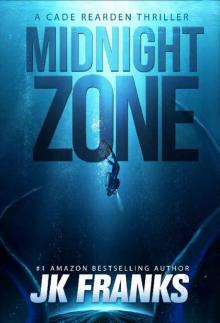 Midnight Zone: a Cade Rearden Thriller
Midnight Zone: a Cade Rearden Thriller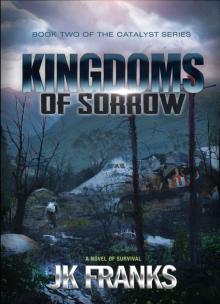 Kingdoms of Sorrow
Kingdoms of Sorrow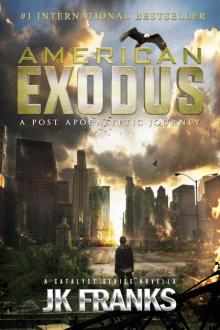 American Exodus
American Exodus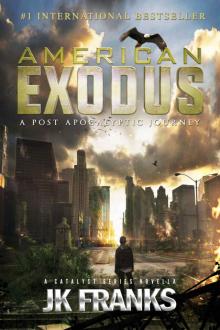 Catalyst
Catalyst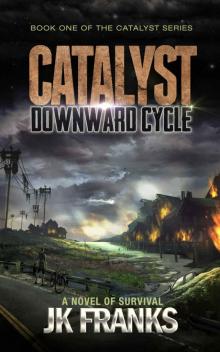 Downward Cycle
Downward Cycle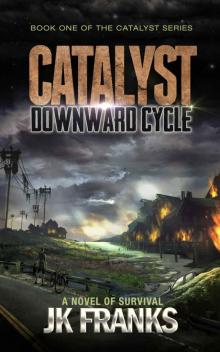 Catalyst (Book 1): Downward Cycle
Catalyst (Book 1): Downward Cycle